I wrote this class, which is one of many that is going to be used for a special DVD. I am sharing this one with you. I hope you enjoy it!
With your legs crossed and your back straight, rest your hands on your knees and let’s do some breathing exercises.
First we will teach you the fundamentals of breathing correctly according to our method. Throughout the exercises inhale and exhale only through your nostrils without making noise.
When you inhale expand your abdomen outward and when you exhale contract your abdomen inward. Remember this rule; when the air enters your abdomen will move outward and when the air leaves your abdomen will move inward.
With this rule memorized, inhale in four seconds and exhale in eight seconds. Repeat this a few times, for more or less 4 minutes, allowing you to absorb this simple rule which will be very useful during your practice. Consequently you are maximising your lungs capacity and oxygenating your entire body, increasing your vitality and improving disposition.
The best way to execute this exercise effectively is to simply pay attention to your breath, experimenting with it and trying not to disperse your concentration. It will give you an amazing sense of well being afterwards.
Remember that we can survive for weeks without food and days without water, but no more than a few minutes without breathing. Oxygen and prana, bio-energy, is the most effective and important way to feed our body.
Let’s move on to the next part of our practice, physical techniques. Please stand up without the aid of your hands and bring your feet together.
Firstly memorize this general rule; when you move any part of your body upwards you inhale, and any part of your body downwards you exhale.
Inhale raising your right knee against your chest. Hold your knee and fix your gaze on a point on the front of you. This will help you to improve your sense of balance.
Now, compensate to the other side, for the same time and with the same intensity. That is another general rule. Whatever position we execute to one side we must do to the other side, in exactly the same way.

Bring your feet together again and inhale, extending your arms above your head, stretching your back. Exhale and move laterally, bending to your right side, resting your right arm on your thigh. Hold the position for a moment while your body benefits from this strong internal massage which vital for your organs. Inhale returning and compensate to the other side, firstly with your arms above your head and then exhale bending to your left side. This position stimulates your adrenal glands, improving their function, which plays an important role in managing stress.
Inhale returning only after you have held the same amount of time to this side.

Now bend your knees preparing to sit. Before touching your hips on the ground hold for a while to gain strength and flexibility in your legs joints.
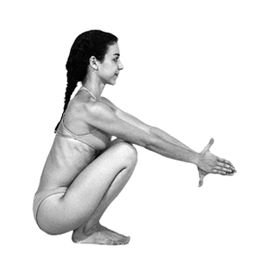
Sit on the floor and extend your legs forward, as gently and quietly as possible.
With your legs straight and feet together, inhale, raising your arms above your head, stretching your back with your lungs full and then exhale, moving your torso forward. Try to keep your arms beside your ears while you move your back. When you have achieved your maximum, release your arms, holding your ankles or feet and relax for while letting your body absorb the effects of the position. Don’t give your maximum movement forward yet. Take some long and deep breaths while you hold this position. Use your breath to relax and release tension. I recommend that you inhale in one time and exhale in twice the time that you inhale, for example if you breathe in in 4 seconds, breathe out in 8 seconds. That is a very effective rhythm to improve your flexibility in this position.
Before you return, give your maximum effort with no air in your lungs. When you need to inhale again, return completely.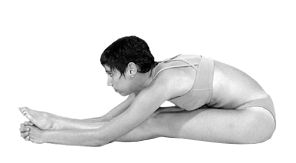
Now lean back forty five degrees, keeping your spine completely straight and raise your legs, trying to bring your feet in the same line of your chest. Hold this position with your lungs completely full, by doing so you are giving more strength to your muscles. Be careful not to curve your back, your body should be in a shape of the letter V.

Rest your legs and place your hands behind your hips with your fingers pointing outward, keeping a fair distance between your hips and hands. Inhale deeply and raise your hips as high as you can. Try to touch your toes on the ground without bending your knees and with your feet together. Hold this position as long as you can improving your general strength and increasing your lungs capacity.
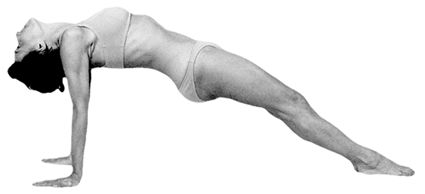
Returning bring your legs bent underneath your hips to sit over your heels.
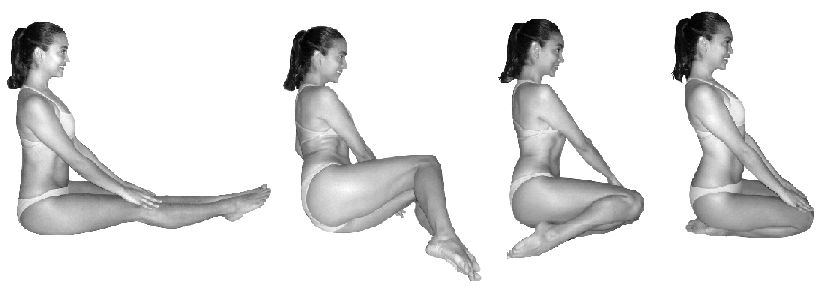
Hold your heels firmly and without releasing your feet, inhale, raise your hips and tilt your head back, forcing your hips forward. This position doesn’t require a long permanence so when you need to exhale, return, sitting over your heels again.
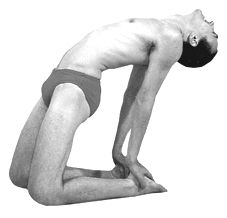
From there pass your legs forward again and lay on your back, you are now going to pass to an inverted position. With your hands firmly on the ground you are going to raise your hips moving your legs towards the ceiling. As soon as you bring your hips up, place your hands on your back to help your balance. Hold this position for as long as you can, the longer the better.
This position will bring the energy that you stimulated during the practice with bigger intensity to your head, benefiting your brain and circulatory system.

To return, place your hands on the floor again and lower your hips without raising your head, as slow as you can.
After this inverted position you must compensate it. Inhale, raising your chest and bring the top of your head on the floor. Lift your chest as high as you can almost touching your forehead on the floor putting the weight of your body on your head, never on your arms which should be resting beside your body, not under it.

Now, resting completely on the floor, try to assimilate what you have achieved with your body. You may feel your back now but if it bothers you, hold your legs bent strongly against your chest to reduce this feeling.
Here we can finish our class for today…
This class is based on the knowledge of Prof DeRose ans his book, specially Tratado de Yôga (Treatise of Yôga) the most complete book of Yôga ever written!











